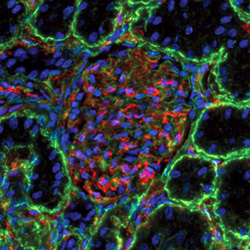
Quantum dots for in vivo imaging
What are quantum dots?
Quantum dots are semiconductor nanoparticles ranging in size from 1nm to 10nm which can be used as fluorescent probes [1,2]. The size of the particle determines the color emitted with smaller particles emitting shorter wavelengths and larger particles emitting longer wavelengths [1,2]. Quantum dots are produced from periodic groups II-VI or III-V materials [2].

Fig. 1 Zn-S capped CdSe quantum dots [3]
How is the light emitted?
Semiconductors contain a conduction band, a band gap, and a valence band and the interaction of all three components imparts the optical properties of the quantum dot [3]. A quantum dot will absorb a photon when enough energy is added into the system to cause an electron to jump from the valence band to the conduction band [3]. This leaves a hole in the valence band where the electron originally was found and an electron-hole pair known as an exciton is produced [4]. A photon or light is emitted when the hole and the electron recombine giving the subsequent phenomenon of fluorescence [3,4].
The small size and the composition of the quantum dots allow the tuning of its optical properties which allows for the large array of colors [2]. The small size of quantum dots causes the energy levels of the different bands to be quantized and directly related to the size of the dots [4]. As the particles increase in size, the band gap increases which results in more energy needed to be absorbed to reach the higher energy levels or the band gap becomes blue shifted [8]. Therefore larger particles emit toward the infrared region while smaller particles emit toward the ultraviolet region[1]. This phenomenon is called "quantum confinement" and applies to particles that are smaller than the Bohr exciton radius (~ few nanometers) [4]. Bulk semiconductors, however, do no possess this property since the energy level spacing is small and resemble more of a continuum [5]. Therefore, above a certain size, optical properties of semiconductor particles resembles those of bulk solids and no longer does the size determine the optical property [5].
This site created by Yuka Okabe
Last Modified: 6/11/2007